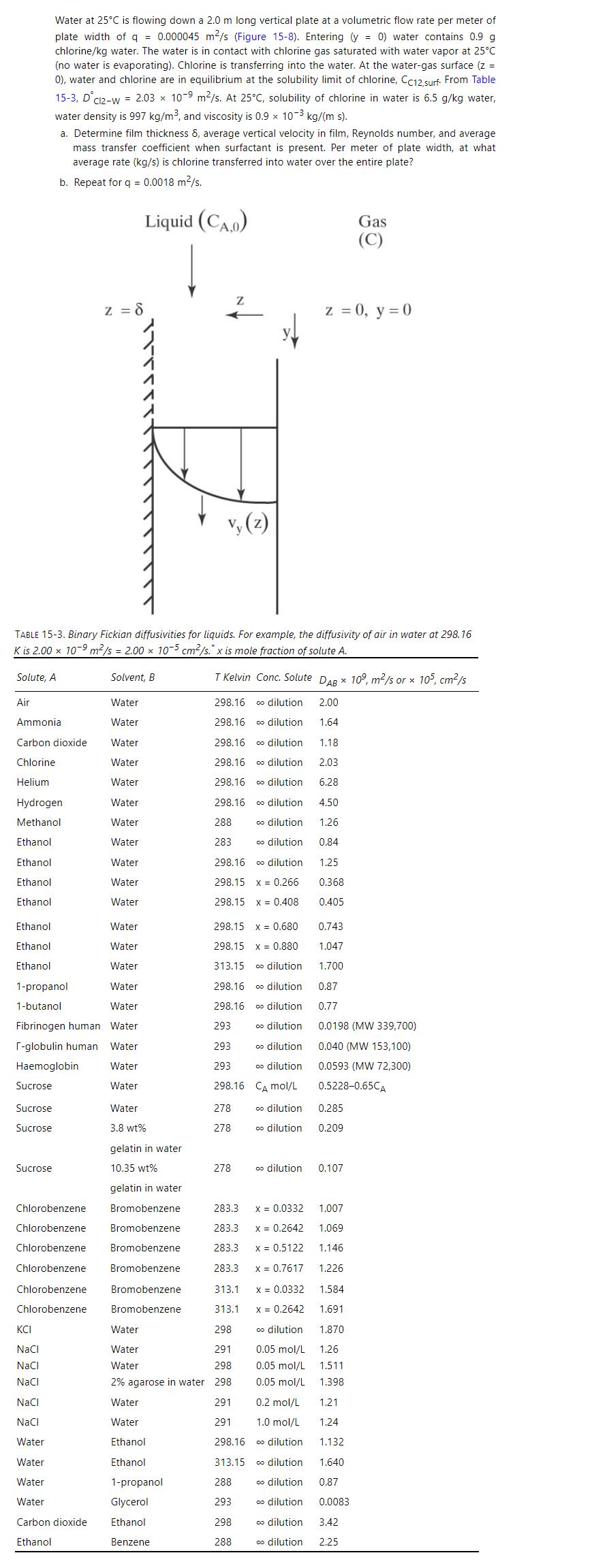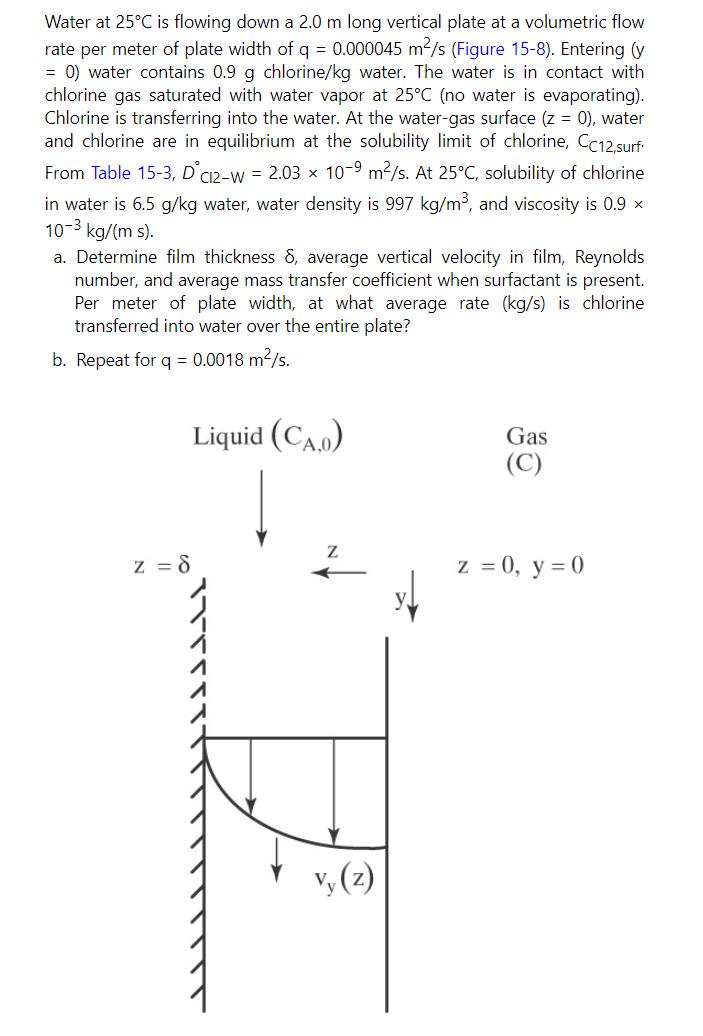Question:
Repeat Example \(15-8\) but for a pressure of \(1.1 \mathrm{~atm}\). Note that the diffusivities depend on pressure. Also answer Problem 15.A6.
Example 15-8

Problem 15.A6
In Problem \(15 . \mathrm{H} 5\) changing the pressure changes the diffusivities but does not change the Henry's law constant of ammonia. However, changing the pressure does change the surface concentrations. Explain.
Problem 15.H5
Repeat Example \(15-8\) but for a pressure of \(1.1 \mathrm{~atm}\). The diffusivities depend on pressure. Also answer Problem 15.A6.
Example 15-8

Transcribed Image Text:
Water at 25C is flowing down a 2.0 m long vertical plate at a volumetric flow rate per meter of plate width of q = 0.000045 m2/s (Figure 15-8). Entering (y = 0) water contains 0.9 g chlorine/kg water. The water is in contact with chlorine gas saturated with water vapor at 25C (no water is evaporating). Chlorine is transferring into the water. At the water-gas surface (z = 0), water and chlorine are in equilibrium at the solubility limit of chlorine, CC12,surf. From Table 15-3, DC12-w = 2.03 x 10-9 m/s. At 25C, solubility of chlorine in water is 6.5 g/kg water, water density is 997 kg/m, and viscosity is 0.9 x 10-3 kg/(m s). a. Determine film thickness 8, average vertical velocity in film, Reynolds number, and average mass transfer coefficient when surfactant is present. Per meter of plate width, at what average rate (kg/s) is chlorine transferred into water over the entire plate? b. Repeat for q = 0.0018 m/s. Liquid (CA.0) Gas (C) z = 8 vy (z) z = 0, y = 0 TABLE 15-3. Binary Fickian diffusivities for liquids. For example, the diffusivity of air in water at 298.16 K is 2.00 x 10-9 m/s = 2.00 x 10-5 cm/s.* x is mole fraction of solute A. T Kelvin Conc. Solute DAB 109, m/s or 105, cm/s Solute, A Solvent, B Air Water 298.16 co dilution 2.00 Ammonia Water 298.16 co dilution 1.64 Carbon dioxide Water 298.16 o dilution 1.18 Chlorine Water 298.16 co dilution 2.03 Helium Water 298.16 o dilution 6.28 Hydrogen Water 298.16 dilution 4.50 Methanol Water 288 o dilution 1.26 Ethanol Water 283 co dilution 0.84 Ethanol Water 298.16 dilution 1.25 Ethanol Water 298.15 x = 0.266 0.368 Ethanol Water 298.15 x 0.408 0.405 Ethanol Water 298.15 x 0.680 0.743 Ethanol Water 298.15 x 0.880 1.047 Ethanol Water 313.15 co dilution 1.700 1-propanol Water 298.16 co dilution 0.87 1-butanol Water 298.16 o dilution 0.77 Fibrinogen human Water 293 dilution 0.0198 (MW 339,700) T-globulin human Water 293 dilution 0.040 (MW 153,100) Haemoglobin Water 293 dilution 0.0593 (MW 72,300) Sucrose Water Sucrose Water 278 298.16 CA mol/L 0.5228-0.65CA co dilution 0.285 Sucrose 3.8 wt% 278 co dilution 0.209 gelatin in water Sucrose Chlorobenzene Chlorobenzene Chlorobenzene Chlorobenzene Chlorobenzene Chlorobenzene 10.35 wt% gelatin in water Bromobenzene Bromobenzene Bromobenzene Bromobenzene Bromobenzene 278 co dilution 0.107 283.3 x = 0.0332 1.007 283.3 x = 0.2642 1.069 283.3 x = 0.5122 1.146 283.3 x = 0.7617 313.1 x = 0.0332 1.226 1.584 Bromobenzene 313.1 x = 0.2642 1.691 KCI Water 298 co dilution 1.870 NaCl Water 291 0.05 mol/L 1.26 NaCl Water 298 0.05 mol/L 1.511 NaCl 2% agarose in water 298. 0.05 mol/L 1.398 NaCl Water 291 0.2 mol/L 1.21 NaCl Water 291 1.0 mol/L 1.24 Water Ethanol 298.16 dilution 1.132 Water Ethanol 313.15 dilution 1.640 Water 1-propanol 288 co dilution 0.87 Water Glycerol 293 co dilution 0.0083 Carbon dioxide Ethanol Ethanol 298 co dilution 3.42 Benzene 288 co dilution 2.25









